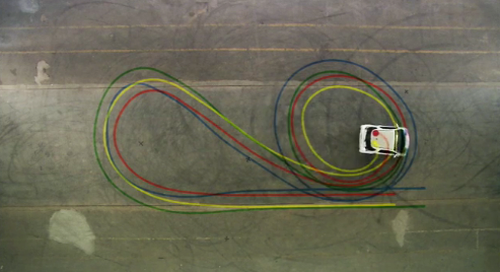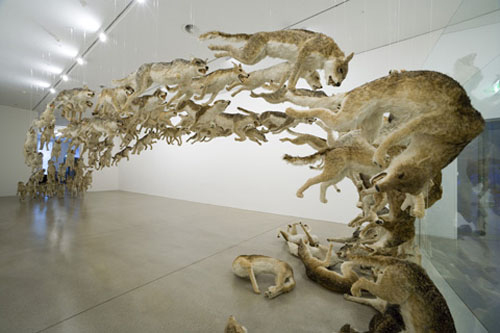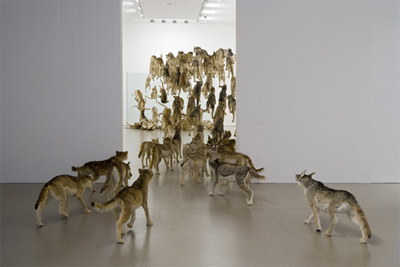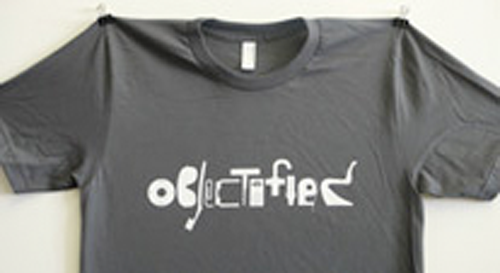Deleting creativity is bad for business.
Deleting creativity is bad for business. A creative idea is the most enduring and reliable way to best competition. via ad age [RK]
Deleting creativity is bad for business. A creative idea is the most enduring and reliable way to best competition. via ad age [RK]
 your zen fix of the day is clearly habit forming.
your zen fix of the day is clearly habit forming.
photo courtesy of zen habits
“In order to be open to creativity, one must have the capacity for constructive use of solitude. One must overcome the fear of being alone.” ~Rollo May
Edited from a post written by Leo Babauta.
Creativity is a nebulous, murky topic that fascinates me endlessly — how does it work? What habits to creative people do that makes them so successful at creativity?
I’ve reflected on my own creative habits, but decided I’d look at the habits that others consider important to their creativity. I picked a handful of creatives, almost at random — there are so many that picking the best would be impossible, so I just picked some that I admire, who came to mind when I thought of the word “creative”.
This was going to be a list of their creative habits … but in reviewing their lists, and my own habits, I found one that stood out. And it stands out if you review the habits and quotes from great creative people in history. It’s the Most Important Habit when it comes to creativity.
The No. 1 Creativity Habit
In a word: solitude.
Creativity flourishes in solitude. With quiet, you can hear your thoughts, you can reach deep within yourself, you can focus.
Of course, there are lots of ways to find this solitude. Let’s listen to a few of the creative people I talked to or researched:
Felicia Day – wonderful actress perhaps best known for her awesome awesome work on Dr. Horrible’s Sing-along Blog, Buffy the Vampire Slayer, and The Guild. One of the things she said: she makes “sure to be creative first thing in the morning, before doing anything for the outside world, really sets the day up for me. It makes it feel that CREATING is my job, not answering emails.”
Ali Edwards – an author, designer, and leading authority on scrapbooking. One of her top habits wasn’t exactly solitude, but is related: “Do nothing. I have a habit of welcoming time away from my creative work. For me this is serious life-recharging time where my only responsibility is to just be Mom & Wife & Me.
Doing nothing has a way of synthesizing what is really important in my life and in my work and inspires me beyond measure. When I come back to work I am better equipped to weed out the non-essential stuff and focus on the things I most want to express creatively.”
Chase Jarvis – an award-winning photographer. “Find Quiet. Creativity sometimes washes over me during times of intense focus and craziness of work, but more often I get whacked by the creative stick when I’ve got time in my schedule. And since my schedule is a crazy one and almost always fills up if I’m just “living”, I tend to carve out little retreats for myself. I get some good thinking and re-charge time during vacations, or on airplanes, but the retreats are more focused on thinking about creative problems that I’m wanting to solve.
That’s why I intentionally carve time out. I make room for creativity. Intentionally. The best example of what I mean by a retreat is a weekend at my family’s cabin. It’s a 90 minute drive from my house on the coast. There are few distractions. Just a rocky beach and a cabin from the 60’s with wood paneling and shag carpet. I go for walks, hikes, naps. I read. I did get an internet signal put in there to stay connected if I need it. But the gist is QUIET. Let there be space for creativity to fill your brain.”
Maciej Cegłowski – painter, programmer, excellent writer. A classically short answer that embodies a beautiful way to find solitude. What habit helps his creativity? Maciej replied: “Running up hills!”
Leo Babauta: OK, I wasn’t going to talk about myself in this post, but I thought I should share some of my previous thoughts.
The best art is created in solitude, for good reason: it’s only when we are alone that we can reach into ourselves and find truth, beauty, soul. Some of the most famous philosophers took daily walks, and it was on these walks that they found their deepest thoughts.
My best writing, and in fact the best of anything I’ve done, was created in solitude.
Just a few of the benefits I’ve found from solitude:
• time for thought
• in being alone, we get to know ourselves
• we face our demons, and deal with them
• space to create
• space to unwind, and find peace
• time to reflect on what we’ve done, and learn from it
• isolation from the influences of other helps us to find our own voice
• quiet helps us to appreciate the smaller things that get lost in the roar
The Greats on Solitude
Wolfgang Amadeus Mozart – prolific and influential composer of the Classical era: “When I am, as it were, completely myself, entirely alone, and of good cheer–say, traveling in a carriage or walking after a good meal or during the night when I cannot sleep–it is on such occasions that my ideas flow best and most abundantly.”
Albert Einstein – theoretical physicist, philosopher and author: “On the other hand, although I have a regular work schedule, I take time to go for long walks on the beach so that I can listen to what is going on inside my head. If my work isn’t going well, I lie down in the middle of a workday and gaze at the ceiling while I listen and visualize what goes on in my imagination.”
Franz Kafka – one of the most influential writers of the 20th century: “You need not leave your room. Remain sitting at your table and listen. You need not even listen, simply wait, just learn to become quiet, and still, and solitary. The world will freely offer itself to you to be unmasked. It has no choice; it will roll in ecstasy at your feet.”
Nikola Tesla – inventor, one of the most important contributors to the birth of commercial electricity: “The mind is sharper and keener in seclusion and uninterrupted solitude. Originality thrives in seclusion free of outside influences beating upon us to cripple the creative mind. Be alone—that is the secret of invention: be alone, that is when ideas are born.”
Joseph Haydn – A life-long resident of Austria, Haydn spent much of his career as a court musician for the wealthy Hungarian aristocratic Esterházy family on their remote estate. Isolated from other composers and trends in music until the later part of his long life, he was, as he put it, “forced to become original”
Johann Wolfgang von Goethe – German writer and polymath: “One can be instructed in society, one is inspired only in solitude.”
Pablo Picasso – Spanish painter best known for co-founding the Cubist movement.
Picasso: “Without great solitude no serious work is possible.”
Carl Sandburg – American writer and editor, best known for his poetry: “One of the greatest necessities in America is to discover creative solitude.”
Thomas Mann – German novelist, short story writer, social critic, philanthropist, essayist: “Solitude gives birth to the original in us, to beauty unfamiliar and perilous — to poetry.”
The No. 2 Creative Habit
While it might seem contradictory, the No. 2 habit when it comes to nurturing creativity: participation.
This can come in many forms, but it requires connecting with others, being inspired by others, reading others, collaborating with others.
But how can you have both solitude and participation? They obviously have to come at different times. Finding the balance is key, of course, but it takes a conscious effort: this time is for solitude, and this time is for participation.
Why are they both important? We need inspiration from without, but we need creation from within.
A couple of the people I interviewed had habits that relate to this:
Chase Jarvis: “Devour Popular Culture. Consuming the works of others inspires me. And it’s not just museums and the “establishment”. I devour magazines, books, street art, performances, music, etc. All things that make me think critically (and whimsically) about the world. You get the picture. Inspiration can come from anywhere.”
Ali Edwards: “Participate. My creative spirit is interested in documenting the wonderful everyday details of our lives. To really get to the heart of the matter I need to be fully participating in my life, in the interactions with my kids and husband and family and friends. If I am just going through the motions or wishing away the present moment for “the next thing” I am missing the blessing of right now. My creativity requires the habit of active participation and daily attention to detail.”
Other creative habits
There are other habits than those top two, of course, that can nourish creativity. Some other good ones:
Felicia Day: “When I am most productive I am the most ruthless with my schedule. I will literally make a daily checklist with, “one hour gym”, “30 minutes of internet research,” and “drink 3 glasses of water” on it. For some reason being that disciplined creates a sense of control that I wouldn’t have otherwise, as a self-employed person, and I get the most out of the scheduled hours that I have for writing.”
Ali Edwards: “Take notes. I am a really good note-taker. It’s essential for me to write down my ideas when they come to mind…otherwise, poof, they disappear way too quickly as I move on to the next task (diaper changes, wiping noses, tending to the stuff of life). I use my phone, my computer, and a moleskine notebook to jot down thoughts and ideas and then I move them into Things every week or so.”
Chase Jarvis:
• Live a creative life everyday. I very much believe in doing creative stuff everyday. For one, I take photos and videos almost everyday. Doesn’t matter the camera. I use my iPhone everyday. Just taking photos keeps me in a creative headspace. Hell, I play with my food and draw and doodle.
• Moderate Expectations. Make it a habit not to judge yourself on your creative output. Sometimes your creativity is on fire. Great news. Other times, it’s not. It’s hard sometimes when you make art in a professional commercial capacity because you’re paid to be ‘ON’, but you’ll save yourself a lot of greif if you make it a habit to be cool to your psyche when your creative mojo isn’t firing on all pistons.
• Shake Your Tree. When I’m starting to feel stale, I make a habit of getting into adventures. Break molds. Drive home from work a different way. Stir up my routine. I get active and shake my tree.
• Find fun. Doing what you love inspires you to be more creative. Make time and space for having fun. All work and no play makes Jane a dull girl.
• Lastly, being creative means living a creative life. Expect yourself to have one. Believe you are creative. Know that you are. Make that the most important habit of all.
For more on creativity, read the author’s Little But Useful Guide to Creativity.
“Creativity is essentially a lonely art. An even lonelier struggle. To some a blessing. To others a curse. It is in reality the ability to reach inside yourself and drag forth from your very soul an idea.” ~Lou Dorfsman
—
[ via zen habits ]
 If you’ve ever wanted to design your own font, step one: get a car.
If you’ve ever wanted to design your own font, step one: get a car.
via drawn
Though a web development article,, follow the dots for other creative solutions. [PR]
 I never know when a person or a company takes me for an exhilarating ride. This list offers potential for that.
I never know when a person or a company takes me for an exhilarating ride. This list offers potential for that.


above: head on, by Cai Guo-Qiang
The order is not mine but taken from FastCompany latest issue, so late in fact that this was compiled the old fashioned way, no cut and paste.
1) Jonathan Ive senior vice president of industrial design. Apple
Melinda Gates cochair, trustee, Bill & Melinda Gates Foundation
Shai Agassi chief executive officer, Better Place
Reed Hastings chief executive officer, Netflix
5) Rich Ross president, Disney Channels Worldwide
Sandy Bodecker vice president global design, Nike
Tero Ojanpera executive vice president, Nokia
Michele Ganeless president, Comedy Central
Jon Rebinstein executive chairman, Palm
10) Jame Schamus chief executive officer, Focus Features
Prith Banerjee director, HP Labs
John Garing chief information officer, Defense Information Systems
Stella McCartney, fashion designer
J.J. Abrams founder, Bad Robot Productions
15) Thom Mayne design director, Morphosis
Dave Morin senior platform manager, Facebook
Stephen Chau product manager, Google Maps and Google Earth
Susan Athey chief economist, Microsoft
Trish Adams senior vice president of merchandising, Target
20) Dawn Danby sustainable design program manager, Autodesk
Tyler Perry owner, Tyler Perry Studios
Damien Hirst artist
Ed Leonard chief technology officer, DreamWorks Animation
Jil Sander designer – creative director, Uniglo
25) Dietrich Mateschitz chief executive officer, Red Bull
Sheila Bair chairman, FDIC
Brenda L. Dietrich vice president, business analytics and mathmatical sciences, IBM
Kazunori Yamauchi president, Polyphony Digital
Alexandra Patsavas owner, Chop Shop Music Supervision
30) George Whitesides inventer – cofounder, Nano-Terra
Hayao Miyazaki cofounder, Studio Ghibli
Lee Clow global director of media arts, TBWAWorldwide
Padmasree Warrior chief technology officer, Cisco
Evan Williams chief executive officer, Twitter
35) Peter Senge founding chairman, Society for Organization Learning
Pharrell Williams musician, producer, cofounder, Billionaire Boys Club
Shai Reshef founder, University of the People
Norman Foster principal, Foster + Partners
Greg Hahn executive creative director, BBDO
40) Neil Gaiman author, screenwriter
Maurice Sendak writer, illustrator, producer
Marc Jacobs fashion designer, LVMH
Neri Oxman presidential fellow, MIT Media Lab
Jean-Georges Vongerichten chef
45) Genevieve Bell director of user experience, Intel Digital Home Group
Jim Jannard chief executive officer, Red Digital Cinema
A.R. Rahman composer
Jimmy Lovine chairman, Interscope Geffen A&M Records
Tyra Banks founder, Bankable Enterprises
50) Lisa Ellis partner, Fireman Capital
Blaise Aguera Y Arcas partner architect, MSN and Microsoft Virtual Earth
Kyle Cooper president, Prologue Films
Sherilyn McCoy worldwide chairman pharmaceutical group
Masamichi Katayama principal, Wonderwall
55) Greg Gillis ( aka Girl Talk ) mashup artist
Charles Rivkin president, chief executive officer, W!ldbrain
Susan Wu chief executive officer, Ohai
June Arunga equity partner, Black Star Lines
Noah Brier head of strategic planning, Barbarian Group
60) Josh Schwartz television producer, writer
Nora Ephron author, director, producer
Hussein Chalayan creative director, Puma
Henrik Werdelin chief creative officer, Joost
Bart Decrem chief creative officer, Tapulous
65) Consuelo Castiglioni creative director, Marni
Bonnie Hammer president, NBC Universal Cable Entertainment
Julieanne Kost senior digital-imagin evangelist, Adobe
Zaha Hadid principal, Zaha Hadid Architects
Dave Stewart musician and record producer
70) Brian Donnelly ( aka Kaws ) artist, designer, owner, OriginalFake
Dr. Anthony Atala director, Wake Forest Institute for Regenerative Medicine
Saul Griffith inventor, cofounder, Makani Power
Dan Barber executive chef, co-owner, Blue Hill Restaurants
Gary Hustwit director, founder, Plexifilm
75) Sam Houser cofounder, Rockstar Games
Piet Oudolf garden designer, Future Plants
Joy Mangano president, Ingenious Designs
David Wiley professor, Brigham Young University
Ed Ulbrich executive vice president of production, Digital Domain
80) Jane McGonigal director of game R&D, Institute of the Future
Karin Hibma and Michael Cronan chief financial officer, chief executive officer, Cronan
Brian Eno musician
Jessica Buttimer director, green works, Clorox
85) Dr. Pier Giulianotti chief of minimally invasive, general, and robotic surgery
Cai Guo-Qiang artist
Joseph Coughlin director, MIT AgeLab
Karin Fong creative director, Imaginary Forces
90) Thom Beers, chief executive officer, producer, Original Productions
Will Allen, chief executive officer, Growing Power
Simon Collins, dean of fashion, Parsons The New School for Design
Bill Bensley, principal, Bensley Design Studios
Kevin Adams, lighting designer
95) Kohei Nishiyama, chief executive officer, Elephant Design
John Swanson, light-rail designer, Parsons Brinkerhoff
Richard Gelfond, chief executive officer, Imax
Scott Schuman, blogger, The Sartorialist
Jenova Chen, creative director, Thatgamecompany
Chris Ferguson, founder, Full Tilt Poker

 From the creator of Helvetica the Movie, Gary Hustwit, comes a new documentary.
From the creator of Helvetica the Movie, Gary Hustwit, comes a new documentary.
Above: sidewalk + snow + stereo in nyc = a production still
Objectified is a feature-length documentary about our relationship to manufactured objects and, by extension, the people who design them. It’s a look at the creativity at work behind everything from toothbrushes to tech gadgets. It’s about industrial designers, the people who re-examine, re-evaluate and re-invent our manufactured environment on a daily basis. It’s about personal expression, identity, consumerism, and sustainability.
World premiere: South by Southwest Festival 2009 ( March Visit 13 – 22 )
Designers featured include: Featuring:
Paola Antonelli (Museum of Modern Art, New York)
Chris Bangle (BMW Group, Munich)
Ronan & Erwan Bouroullec (Paris)
Andrew Blauvelt (Walker Art Center, Minneapolis)
Tim Brown (IDEO)
Anthony Dunne (London)
Dan Formosa (Smart Design)
Naoto Fukasawa (Tokyo)
Jonathan Ive (Apple, California)
Hella Jongerius (Rotterdam)
David Kelley (IDEO)
Bill Moggridge (IDEO)
Marc Newson (London/Paris)
Fiona Raby (London)
Dieter Rams (Kronberg, Germany)
Karim Rashid (New York)
Alice Rawsthorn (International Herald Tribune)
Davin Stowell (Smart Design)
Jane Fulton Suri (IDEO)
Rob Walker (New York Times Magazine)
and more participants TBA
Visit objectifiedfilm.com for more info and screening dates. Thanks Jilly.
All content ©2007 > 2024 DesignApplause